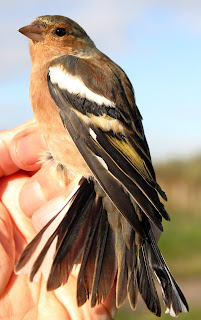I tried again this morning and returned to Lane Ends now that the sportsmen moved on. A slight change of tactics today after the Yellow-browed Warbler at Heysham yesterday had me looking harder for both a YBW in the trees and a Lapland Bunting along the shore, but the anniversaryies of finding such exotica here in a mist net isn’t until the 18th October and the 24th October respectively; 1998 and 1987 were the unexpected occasions, almost a lifetime away such is the mundane nature of my everyday ringing.
I started well enough with a clear view of the pool where the Little Grebe I have been hearing for weeks turned into not one but four. A quiet walk around the bottom car park and the other pool found the resident Kingfisher that shot through the trees and over to the pool I just left, but apart from Robins and a few Blackbirds, warblers were absent.
It was going to be something of a raptor morning because I hadn’t gone far towards Pilling Water when I saw a Kestrel, a Sparrowhawk and a Merlin. I think the latter two were after one of the many Skylarks around this morning, of which I counted 90+ birds, some of this attributable to the incoming tide pushing birds off the marsh and over the sea wall. I soon notched up a Peregrine too when one appeared briefly and sped over towards the stubble where there was a gang of Pink-footed Geese, just some of the 11,000+ I counted this morning. There was also a not very well bird, a left over from yesterday’s shoot, but I didn’t have the heart to put it out of its misery.




I made a few counts of waders and wildfowl, not in any particular order, 80 Dunlin, 65 Redshank, 1 Golden Plover, 15 Grey Plover, 11 Snipe, 300 Curlew, 13 Little Egret, and 2 Greenshank. Wildfowl - 750 Teal, 240 Wigeon, 40 Pintail, 5 Cormorant, 4 Great-crested Grebe, 2 Red-breasted Merganser, 165 Shelduck and 2 Mute Swan.
I turned my attention back to the sea wall when I got distracted into photography again as 12 Meadow Pipits, 3 Wheatears and half a dozen Linnets fed almost along the tideline at the base of the sea wall close to where I sat. The Linnets evaded my camera but the others didn’t.



Up near Worm Pool I could see 20 or so corvids harassing a Buzzard so I set off in that direction, almost treading on a Grey Partridge in the process, but by the time I got closer to Fluke Hall the Buzzard had drifted inland. Oh well, I’d just seen five raptors in the space of an hour or two, not a bad morning’s work.










































.jpg)













